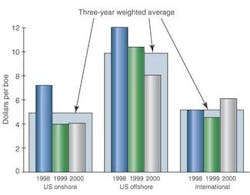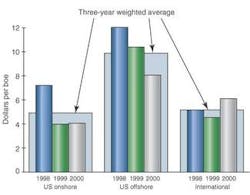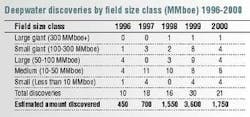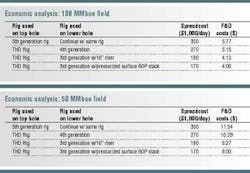Reducing deepwater finding costs with systemic approach to multi-well projects
Dr. Keith Millheim
Anadarko Petroleum
Allen Gault
Consultant
The price of a barrel of oil relative to its finding and development cost determines whether a field is economically viable. The billion-barrel fields recently dis-covered in ultra-deepwater Gulf of Mexico can support the high "spread costs" necessary for development, but how will the smaller, ultra-deep fields be developed?
A 100-300 MMboe field may be considered a giant in conventional water depth, but may not be economic in deepwater where spread costs run as high as $350,000-$400,000 per day. Deepwater development of a 50-100 MMboe field at these prices would be out of the question.
Considering that most recent discoveries, as well as those expected in the near term, fall into the 50-300 MMboe range, a solution is needed to economically develop such finds in deepwater. Without enabling technology and a corresponding decrease in finding and development (F&D) costs, these reserves may remain out of reach, despite the urgency surrounding oil supply.
F&D costs
One 2002 analysis of reserve replacement costs indicates that average finding and development costs for the 50 largest US operators rose from just under $5/boe in 1999 to $8.20/boe in 2001 (Oil and Gas International, May 15, 2002.). Offshore wells and deepwater, in particular, are generally more expensive than onshore or shelf wells. Finding costs for the Gulf of Mexico rose sharply between 1993 and 2000, due largely to drilling costs, which accounted for over 50% of the increase in that region ("Performance Profiles of Major Energy Producers: Resource Development Trends," Energy Information Administration, Department of Energy, Jan. 11, 2002.).
These costs are key performance indicators for many operators because they can be controlled to some extent. Therefore, increased efficiency and/or reduced costs in any aspect of the drilling operation contribute to the economic viability of a particular field.
The rig fleet built to service ultra-deepwater fields, however, share design characteristics specifically suited to "giant" field economics. These include huge fluid storage facilities, thousands of feet of 21-in. marine riser, highly sophisticated positioning apparatus, and a totally computerized drilling management systems. To make smaller fields economical, the operator should consider alternative drilling technologies and well designs.
null
Out of the box
In the last few years, several non-conventional approaches to drilling have been successfully tested. Most of these could be commercially feasible in the near future. Promising technologies include casing drilling (using a specialized rig), expandable casing, surface BOPs (offshore), smaller lighter risers, and dual density systems.
Adopting one or more of these technologies requires a paradigm shift in well construction practices. To enjoy the economic benefits of non-conventional approaches, the operator must develop a systemic view that encompasses drilling, completion, and production planning for multiple wells rather than concentrating on a single well.
Top hole drilling
One of the more promising dual density technologies in terms of cost reduction is the top hole drilling (THD) system. The typical THD scenario mobilizes a specially equipped third- or fourth-generation drillship or semisubmersible to drill the top-hole portion of the well at a relatively low spread cost.
After surface casing is set, the lower portion of the well can be drilled with another third- or fourth-generation rig, or a fifth generation drillship can be moved to the wellsite if required. The use of the smaller rig(s) would reduce F&D costs significantly.
Two-rig concept
The THD system allows operators to extend the riserless top-hole interval by drilling with a closed system rather than discharging mud returns at the seafloor. The THD system is a modification of the subsea mudlift dual gradient drilling (SMD) system that was successfully field tested in the Gulf of Mexico in 2001.
While the prototype was developed to alleviate issues with narrow pore pressure/fracture gradient margins in the lower wellbore, the THD system provides a closed loop configuration for drilling the top-hole intervals up to the 13 5/8-in. casing point (where high-pressure subsea blowout preventers are required). By extending the top-hole casing point, the THD system may eliminate one or more intermediate casing strings.
After the top hole is completed, the THD rig moves off location and a third- or fourth-generation rig moves on the wellsite to drill the remainder of the hole at a relatively low spread cost.
The THD system integrates proven technologies in an unconventional configuration, resulting in significant weight reduction on the rig, primarily related to fluid volumes. The system has been field tested and proven to operate as designed, making the risk component manageable where innovative components and processes are concerned. Further, the system provides specific advantages in well control, shallow hazard management, and environmental protection and is acknowledged by the US Minerals Management Service as a potential enhancement to existing deepwater practices.
Adapting the equipment on an existing rig requires an estimated initial investment of $15 million, but the potential operating cost reduction and increased number of economically viable fields – plus the increased contracting opportunities for smaller rigs – make the THD system worth serious consideration.
Market and technical challenges
As with any significant evolution in drilling technology, the THD system faces a number of challenges before it can gain wide acceptance. While the cost benefits to operators seem evident, the drilling contractor must view THD from the perspective of its impact on the existing rig fleet.
Once fitted with the appropriate surface and subsea equipment, the THD rig is used to drill 25% of each well. As few as two or three THD rigs would be needed to service the deepwater market in the Gulf of Mexico. This means interventions, plug and abandonment jobs, and workover contracts may be necessary to maintain THD rig utilization at a profitable level.
From the operator's perspective, maximizing the benefits of the THD system requires careful advance planning. A significant period of time might elapse between the completion of the upper portion of the well and beginning drilling on the lower wellbore. The operator must think in terms of a drilling "campaign" rather than relying on single well strategies. Further, though it has been successfully field tested at a water depth of 1000 ft, the THD system is still considered an operational risk.
Training is also an issue. While the system appears to meet or exceed all regulatory requirements, the drilling and well control operations differ from the practices long familiar to drilling personnel, and industry standards for dual density drilling systems have not yet been established.
Despite these and other challenges, the potential value of using the THD system for multi-well and multi-field applications is clear. A THD rig can be used to drill top holes on a template, leaving an inventory of wellbores ready to be drilled immediately, or to be serviced later with rigs of opportunity as dictated by economics.
Similarly, a fit-for-purpose THD rig could be used solely for exploration and/or delineation wells, lowering the finding costs while making it possible to book reserves accurately. In the current climate of rapidly fluctuating oil prices and real threats to the existing oil supply, the drilling flexibility offered by the THD system provides a method to tap into reserves quickly without expensive and complicated mobilization issues.
Supporting step-change technology
The numerous advances in technology made in the last decade have not yet reduced the size of deepwater fields categorized as "marginally economic." Though the price of oil is a major factor in these calculations, a dramatic step-change in technology can provide economic benefits even when the price of oil is relatively low.
At this point in time, the status of the THD system is similar to the early stages of top drive technology, first introduced in the 1980s. At that time, operators saw the value in being able to rotate while pulling out of the hole or running casing (essential to horizontal drilling operations) and the flat time reduction achieved by making up stands instead of joints while tripping in the hole.
As the top drive proved itself, the equipment became a standard item in every offshore rig bid. Still, contractors kept a kelly and kelly bushing on hand for the first few years just in case of failure.
Like the top drive technology of the 1980s, the THD system deserves a champion willing to put a top-hole rig to work and begin to assess its multiple capabilities. These include improved field economics, increased deepwater utilization of smaller rigs, lower spread costs, deeper surface casing points, reduced drilling fluid volumes, more efficient shallow hazard management, and improved health, safety, and environment characteristics.
A number of significant projects have focused on dual density solutions for deepwater drilling challenges. Among these are the SMD joint industry project, which produced the prototype for the THD system, Maurer Engineering's spherical bead injection, ExxonMobil's gas lift technology, Shell's positive displacement motor system, and the investigations conducted by the DeepVision group. Information on dual density technology is available at the following websites:
- www.hydril.com/subsea/INTRO.htm
- www.weatherford.com/mpd
- www.dgsolution.co
- www.pslg.no/pipeline/service_produkt/c_riserless_mud.html.
Authors
Allen Gault, PE, BS, MS, consultant, Petroleum Engineers International, is retired from Conoco and is a consultant with PEI.
Dr. Keith Millheim, joined Anadarko Petroleum Corp. in 2000 as manager of Operations Technology. Prior to that, he served as the director of the Mewbourne School of Petroleum and Geological Engineering at the University of Oklahoma.
Terri Smith, technical writer, BA, MA, Terri Smith Inc., assisted with the research and editing of this article.



